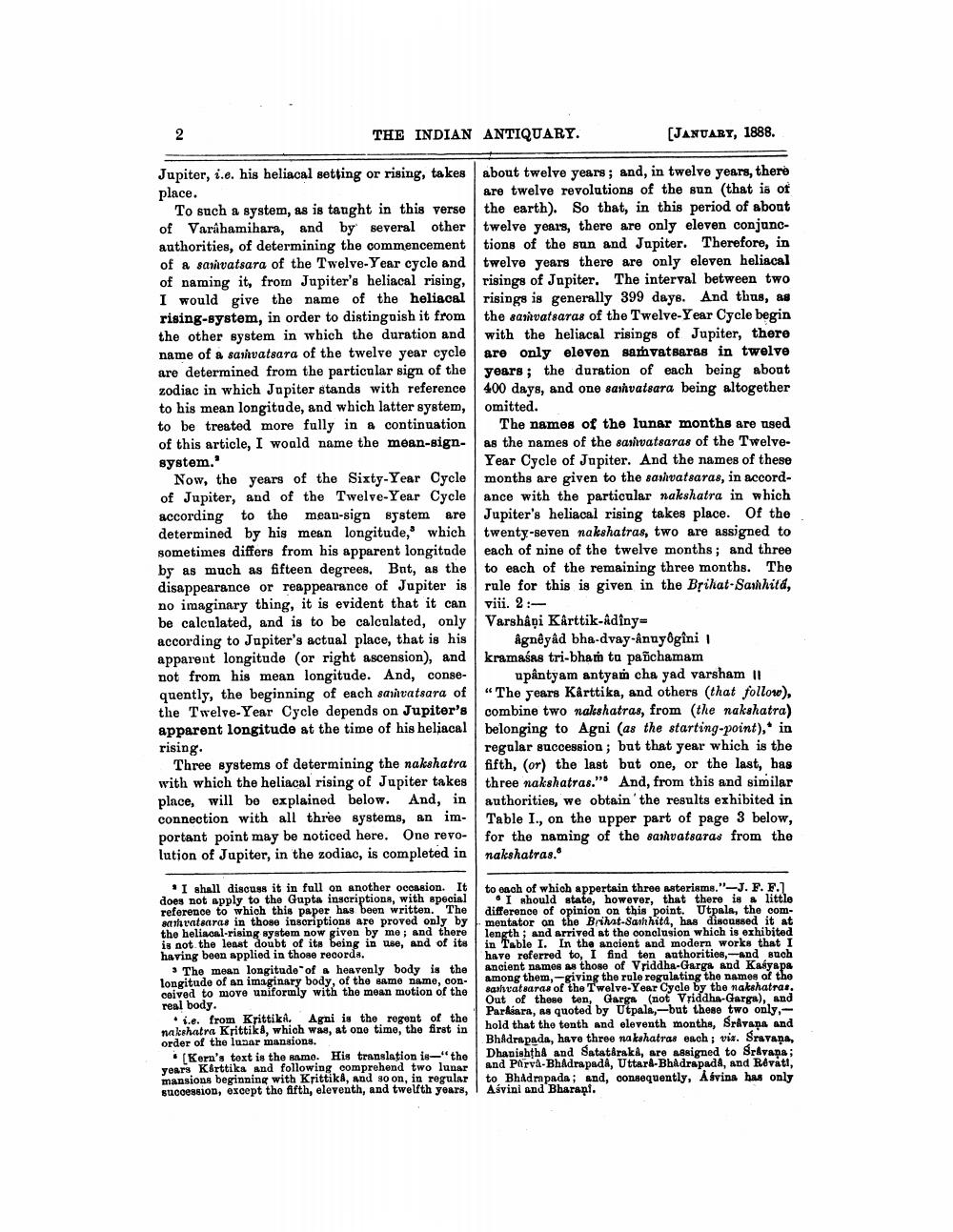Book Title: Indian Antiquary Vol 17 Author(s): John Faithfull Fleet, Richard Carnac Temple Publisher: Swati Publications View full book textPage 8
________________ THE INDIAN ANTIQUARY. (JANUARY, 1888. Jupiter, i.e. his heliacal setting or rising, takes about twelve years; and, in twelve years, there place. are twelve revolutions of the sun (that is of To such a system, as is taught in this verse the earth). So that, in this period of about of Varahamihara, and by several other twelve years, there are only eleven conjuncauthorities, of determining the commencement tions of the sun and Jupiter. Therefore, in of a sarivatsara of the Twelve-year cycle and twelve years there are only eleven heliacal of naming it, from Jupiter's heliacal rising, risings of Jupiter. The interval between two I would give the name of the heliacal risings is generally 399 days. And thus, as rising-system, in order to distinguish it from the sarhvatsaras of the Twelve-Year Cycle begin the other system in which the duration and with the heliacal risings of Jupiter, there name of a sashvatsara of the twelve year cycle are only eleven samvatsaras in twelve are determined from the particular sign of the years; the duration of each being about zodiac in which Jupiter stands with reference 400 days, and one sarvatsara being altogether to his mean longitude, and which latter system, omitted, to be treated more fully in a continuation The names of the lunar months are used of this article, I would name the mean-sign- as the names of the sasivatsaras of the Twelvesystem.' Year Cycle of Jupiter. And the names of these Now, the years of the Sixty-Year Cycle months are given to the sasivatsaras, in accordof Jupiter, and of the Twelve-Year Cycle ance with the particular nakshatra in which according to the mean-sign system are Jupiter's heliacal rising takes place. Of the determined by his mean longitude, which twenty-seven nakshatras, two are assigned to sometimes differs from his apparent longitade each of nine of the twelve months; and three by as much as fifteen degrees. But, as the to each of the remaining three months. The disappearance or reappearance of Jupiter is rule for this is given in the Brihat-Sarhitá, no imaginary thing, it is evident that it can viii. 2:be calenlated, and is to be calculated, only | VarshApi Karttik-Adinyaccording to Jupiter's actual place, that is his ågnêyad bha-dvay-Annyogini apparent longitude (or right ascension), and kramasas tri-bhar ta pañchamam not from his mean longitude. And, conse- upantyam antyam cha yad varsham II quently, the beginning of each sauvatsara of “The years Kárttika, and others (that follow), the Twelve-Year Cycle depends on Jupiter's combine two nakshatras, from the nakshatra) apparent longitude at the time of his heliacal belonging to Agni (as the starting-point),* in rising. regular succession ; but that year which is the Three systems of determining the nakshatra fifth, (or) the last but one, or the last, has with which the heliacal rising of Jupiter takes three nakshatras." And, from this and similar place, will be explained below. And, in authorities, we obtain the results exhibited in connection with all three systems, an im- Table I., on the upper part of page 3 below, portant point may be noticed here. One revo- for the naming of the sasivatsaras from the lution of Jupiter, in the zodiac, is completed in nakshatras. "I shall discuss it in full on another occasion. It does not apply to the Gupta inscriptions, with special reference to which this paper has been written. The anh vatsarae in those inscriptions are proved only by the beliacal-rising system now given by mo; and there is not the least doubt of its being in use, and of its having been applied in those reoorde. The mean longitude of heavenly body is the longitude of an imaginary body, of the same name, conceived to move uniformly with the mean motion of the real body. • i.e. from Krittika. Agni is the regent of the nakshatra Krittik &, which w , at one time, the first in order of the lunar mansions. . (Kern's toxt is the samo. His translation is-"the years Korttiks and following comprehend two lunar mansions beginning with Krittika, and so on, in regular succession, oxcept the fifth, eleventh, and twelfth years, to each of which appertain three asterisms."-J. F.F.l I should state, however, that there is a little difference of opinion on this point. Utpala, the com. mentator on the Brihat-Sanhhita, has discussed it at length; and arrived at the conclusion which is exhibited in Table I. In the ancient and modern works that I have referred to. I find ten authorities, and such ancient names as those of Vriddha-Garga and Kasyapa among them, giving the rule regulating the names of the sarhvat saras of the Twelve-Year Cycle by the nakshatrat, Out of these ten, Garga (not Vriddha-Garga), and Parfsara, as quoted by Utpala, but these two only, hold that the tenth and eleventh months, Sravana and Bhadrapada, have three nakshatras each ; vix. Sravana, Dhanishtha and Satatdraka, are assigned to Srivapa; and Phrva-Bhadrapada, Uttarl-Bhadrapada, and Revati, to Bhadrapada; and, consequently, Åsvins has only Ašvini and Bharani.Page Navigation
1 ... 6 7 8 9 10 11 12 13 14 15 16 17 18 19 20 21 22 23 24 25 26 27 28 29 30 31 32 33 34 35 36 37 38 39 40 41 42 43 44 45 46 47 48 49 50 51 52 53 54 55 56 57 58 59 60 61 62 63 64 65 66 67 68 69 70 71 72 73 74 75 76 77 78 79 80 81 82 ... 430
